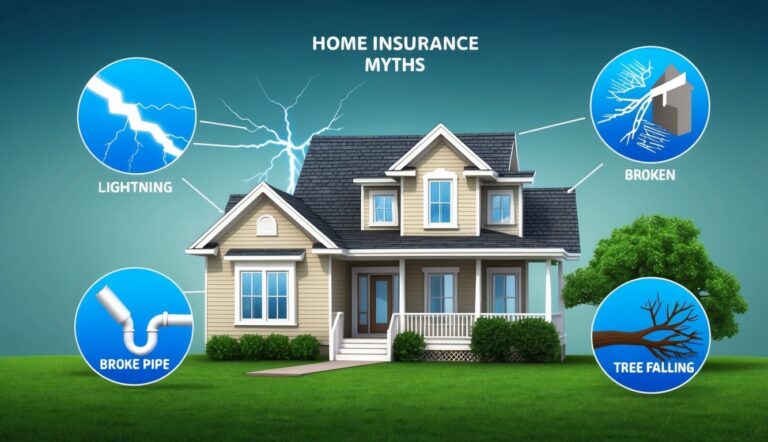Home insurance is a crucial aspect of protecting your property and financial well-being.
However, many homeowners hold misconceptions about their policies and coverage.
These myths can lead to costly mistakes and inadequate protection for your most valuable asset.
Understanding the truth behind common home insurance myths can help you make informed decisions and ensure proper coverage for your home. By debunking these misconceptions, you’ll be better equipped to choose the right policy and avoid potential pitfalls.
Let’s examine ten prevalent home insurance myths and uncover the facts you need to know.
1) Standard Homeowners Insurance Covers Flood Damage
This is a widespread misconception that can leave homeowners vulnerable to significant financial losses.
Standard homeowners insurance policies typically do not cover flood damage.
Flood insurance is a separate policy that must be purchased in addition to your regular homeowners insurance.
Many people don’t realize this until it’s too late.
The National Flood Insurance Program (NFIP) provides flood insurance to homeowners in participating communities.
You can buy this coverage regardless of where you live, as long as your community is part of the NFIP.
It’s crucial to understand what your policy covers.
Homeowners insurance usually protects against water damage from things like burst pipes or leaking roofs.
However, it doesn’t cover damage from rising water or storm surges.
If you live in a high-risk flood zone, your mortgage lender may require you to have flood insurance.
Even if you’re not in a high-risk area, it’s worth considering this coverage.
Don’t assume you’re safe just because you haven’t experienced flooding before.
Climate change is increasing flood risks in many areas.
It’s better to be prepared than to face unexpected costs after a disaster.
Remember, there’s usually a 30-day waiting period before flood insurance takes effect.
Don’t wait until a storm is on the horizon to purchase coverage.
2) Home Insurance Is Expensive
Many homeowners believe that home insurance is too costly, but this isn’t necessarily true.
The average cost of homeowners insurance is around $158 per month, which is often less than people expect.
You can find ways to make your insurance even more affordable.
Shopping around for quotes from different providers can help you find the best rates for your needs.
Raising your deductible is another effective strategy to lower your premiums. Going from a $500 to a $1,000 deductible can reduce your premium by 25 percent.
Consider bundling your home insurance with other policies, like auto insurance.
Many companies offer discounts for combined coverage.
Improving your home’s safety features can also lead to lower premiums.
Installing smoke detectors, security systems, or storm shutters may qualify you for discounts.
The cost of insurance is relative to the value it provides. The average cost to rebuild a home in 2022 was $284,764.
Compared to this potential expense, the cost of insurance is often a worthwhile investment for protecting your home and belongings.
3) Home Insurance Automatically Covers All Personal Belongings
Many homeowners mistakenly believe their insurance policy covers all their personal belongings.
This is not always the case.
Standard home insurance policies do provide coverage for personal property, but there are often limits.
These limits can vary depending on the type of item and its value.
Expensive items like jewelry, art, or collectibles may have specific coverage limits.
For example, jewelry coverage might be capped at $1,500.
To protect valuable items exceeding standard limits, you may need to purchase additional coverage.
This can be done through riders or endorsements to your existing policy.
It’s important to carefully review your policy to understand what is and isn’t covered.
Don’t assume that everything you own is automatically protected.
Creating a home inventory can help you determine if your current coverage is sufficient.
This list should include all valuable items along with their estimated worth.
If you have high-value items, consider getting them professionally appraised.
This can help ensure you have adequate coverage in case of loss or damage.
Remember, your policy may also have exclusions for certain types of damage.
For instance, flood damage is typically not covered by standard home insurance policies.
4) Older Homes Are Not Insurable
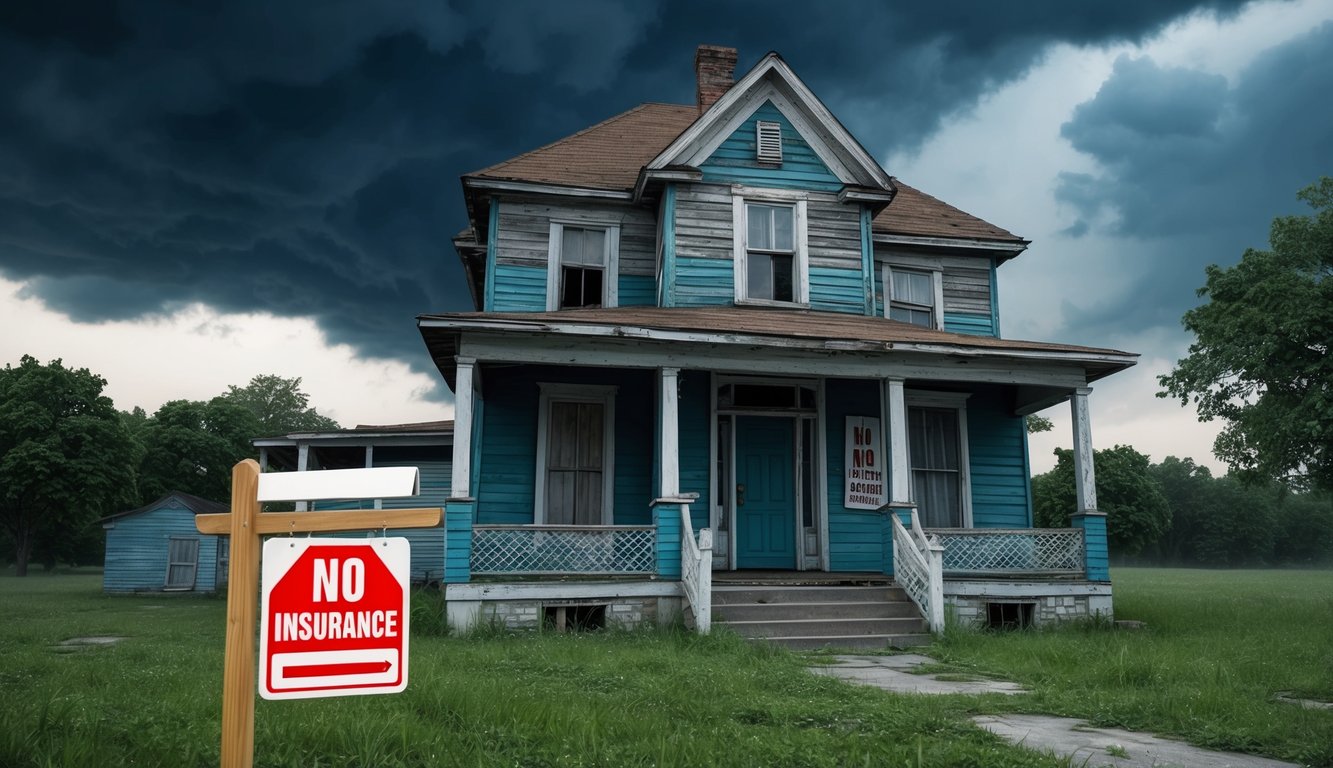
Contrary to popular belief, older homes are indeed insurable.
Many insurance companies offer coverage for houses that are more than 50 years old.
However, insuring an older home can be more complex and potentially more expensive than insuring a newer property.
This is due to several factors that insurers consider when assessing risk.
Older homes may cost more to insure than newer ones.
Aging materials and outdated building codes can make these properties more susceptible to damage, increasing the likelihood of insurance claims.
Some insurers specialize in coverage for historic or older homes.
These companies understand the unique challenges and value of such properties.
When seeking insurance for an older home, you might need to provide additional information about the property’s condition, recent renovations, and maintenance history.
Updating key systems like electrical wiring, plumbing, and roofing can help reduce insurance costs for older homes.
These improvements lower the risk of damage and demonstrate responsible homeownership.
Some insurers offer specialized policies for high-value older properties.
These may include features like extended replacement cost coverage to protect against unexpected repair expenses.
5) Home Insurance Is Not Necessary for New Homes
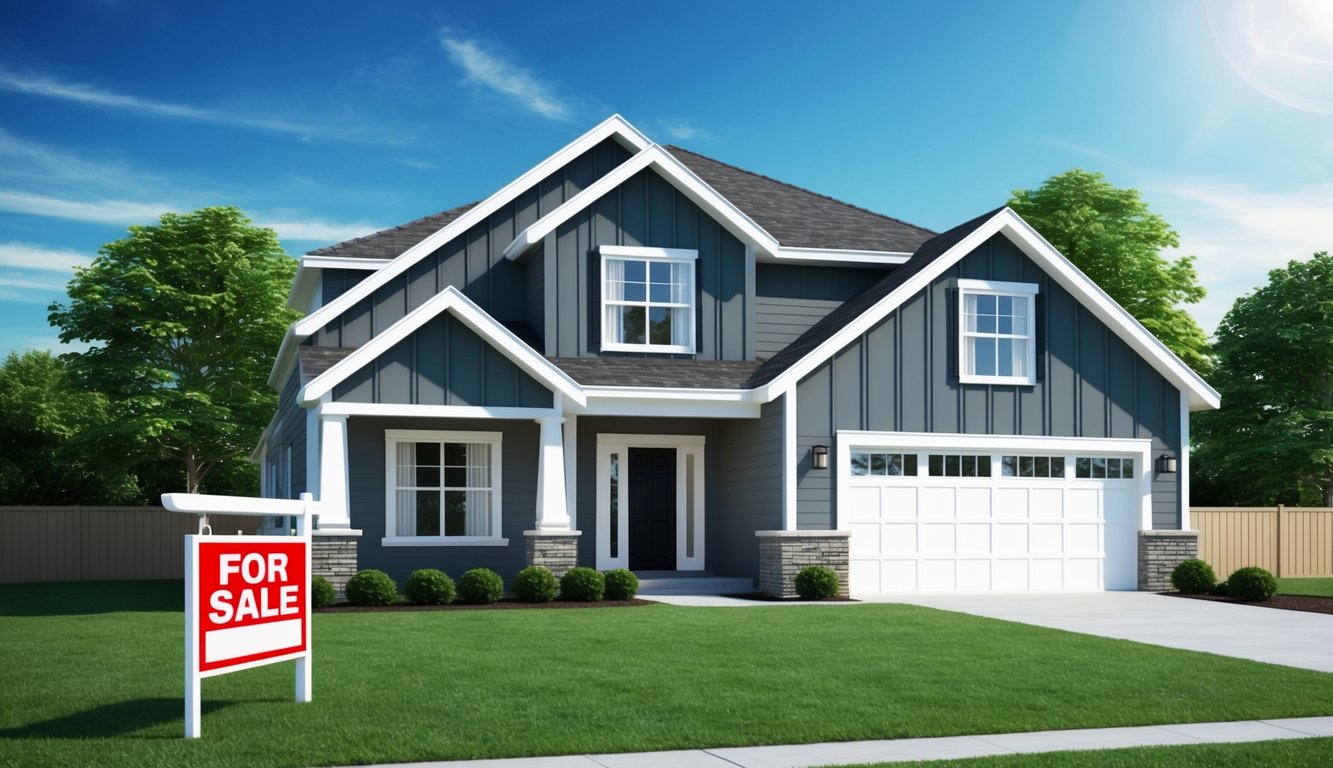
This myth can lead to costly mistakes.
New homes are not immune to risks and damages that home insurance covers.
Natural disasters don’t discriminate between old and new homes.
A fire, tornado, or hurricane can damage a newly built house just as easily as an older one.
Theft and burglary can happen anywhere, regardless of a home’s age. Home insurance covers burglaries, protecting your belongings in new and old homes alike.
Construction defects may not be apparent immediately.
Issues can arise months or years after completion, potentially causing significant damage.
Liability protection is crucial for all homeowners.
If someone is injured on your property, you could be held responsible, whether your home is new or not.
New homes often have modern, expensive features.
These may cost more to replace, making insurance even more important to protect your investment.
Mortgage lenders typically require home insurance, even for new construction.
It’s a safeguard for their investment and yours.
6) Homeowners Insurance and Property Insurance Are the Same
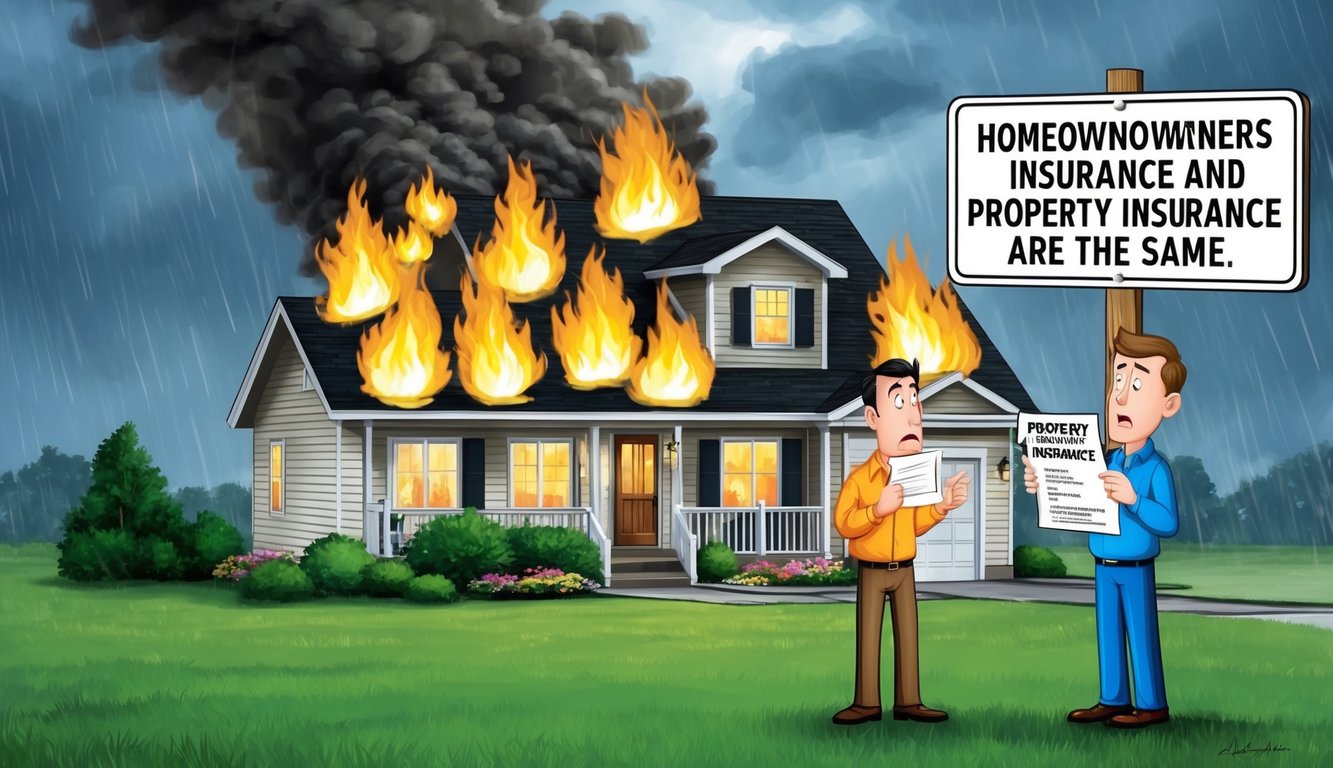
Many people mistakenly believe that homeowners insurance and property insurance are interchangeable terms.
This is not the case.
Property insurance is a broader category that includes various types of coverage.
It encompasses protection for different kinds of property, including homes, cars, and businesses.
Homeowners insurance, on the other hand, is a specific type of property insurance.
It’s designed to protect your home and personal belongings against certain risks.
When you purchase homeowners insurance, you’re getting coverage for your dwelling, personal property, and liability.
This policy typically protects against perils like fire, theft, and certain natural disasters.
Property insurance can include coverage for other structures beyond your home, such as vehicles or commercial buildings.
It’s an umbrella term that encompasses multiple insurance types.
It’s important to understand the distinction between these terms.
When shopping for insurance, you need to be clear about what type of coverage you’re seeking.
If you own a home, you’ll want to specifically look for homeowners insurance.
This will ensure you have the right protection for your house and personal belongings.
Not all property insurance policies will provide the comprehensive coverage you need for your home.
Always read the details of any policy carefully before making a decision.
7) Home Insurance Will Cover All Natural Disasters
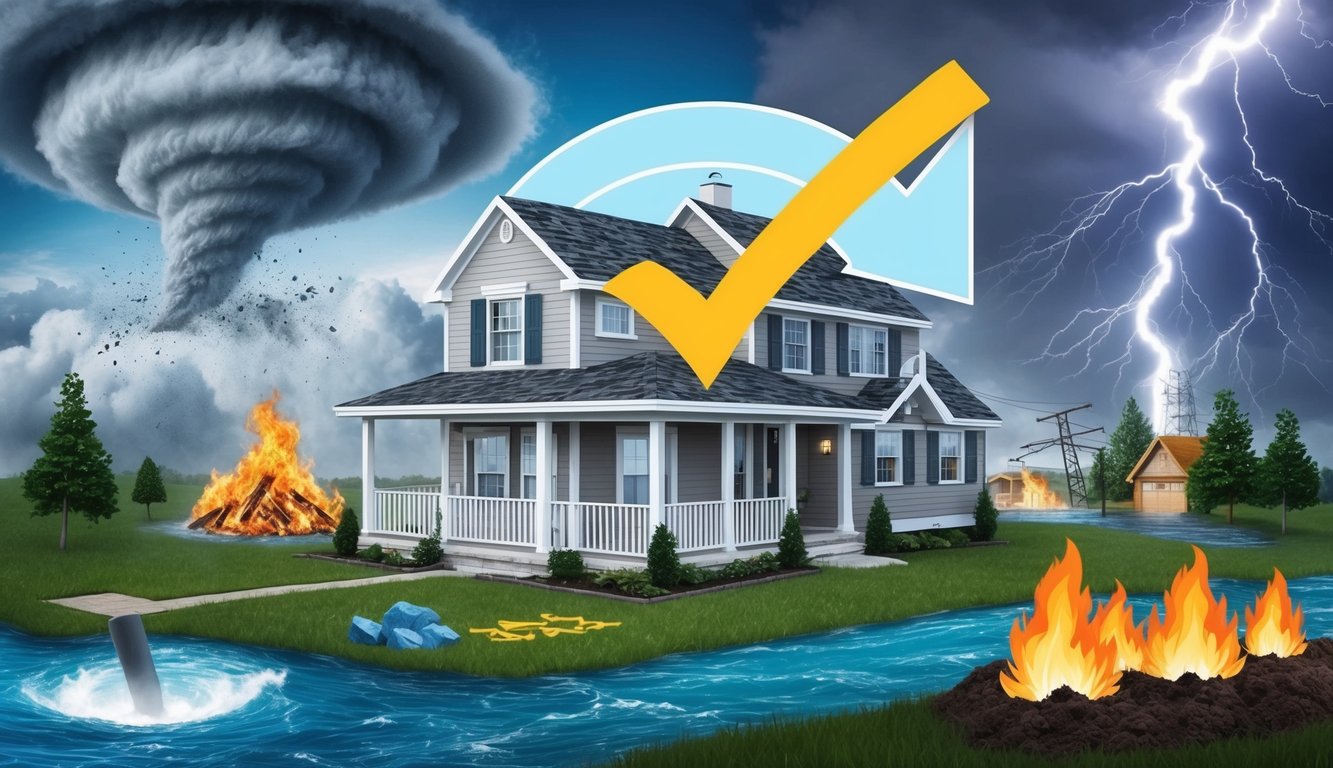
Many homeowners mistakenly believe their insurance policy protects them from all natural disasters.
This is not the case.
Standard home insurance typically covers damage from certain events like fire, wind, and hail.
However, it’s crucial to understand that not all natural disasters are covered by a standard policy.
Floods and earthquakes, for example, often require separate insurance policies.
You should review your policy carefully to understand what’s included and what’s not.
Some policies may cover water damage from burst pipes but not from rising floodwaters.
If you live in an area prone to specific natural disasters, you might need additional coverage.
For instance, if your home is in a flood zone, you’ll likely need to purchase a separate flood insurance policy.
It’s also worth noting that even for covered events, you’ll typically need to pay a deductible before your insurance kicks in. The amount of your deductible can vary, so be sure to check your policy details.
Don’t assume you’re fully protected without carefully reviewing your coverage.
Speak with your insurance agent to ensure you have the right protection for your specific needs and location.
8) Insurance Premiums Always Go Up After a Claim
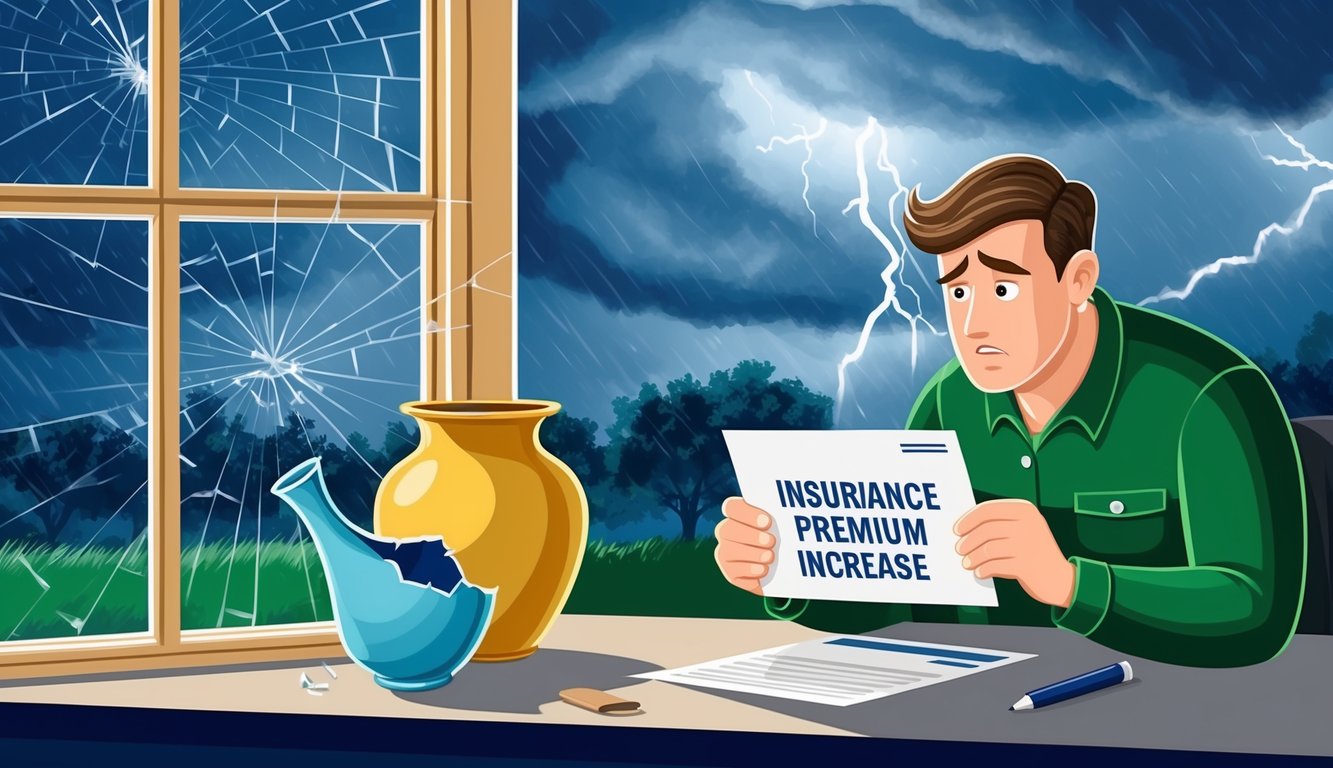
Many homeowners believe filing a claim will automatically increase their insurance premiums.
This isn’t always true.
While some claims can lead to rate increases, it’s not a universal rule.
Several factors influence whether your rates will change after a claim.
These include the type of claim, your claims history, and the specific policies of your insurance provider.
Severe weather events in your area can impact premiums more significantly than individual claims.
If you live in a region prone to natural disasters, you might see rate increases even without filing a claim.
Your personal claims history plays a crucial role.
Multiple claims within a short period are more likely to result in higher premiums than a single isolated claim.
Some insurance companies offer claim forgiveness programs.
These programs protect you from rate increases after your first claim or if you’ve been claim-free for a certain period.
Before filing a claim, consider its potential impact on your rates.
For minor damages, it might be more cost-effective to pay out of pocket rather than risk a premium increase.
Remember, your insurance is there to protect you from significant financial losses.
Don’t hesitate to use it when necessary, but be strategic about when you file claims to maintain stable premiums.
9) Minor Damage Isn’t Covered
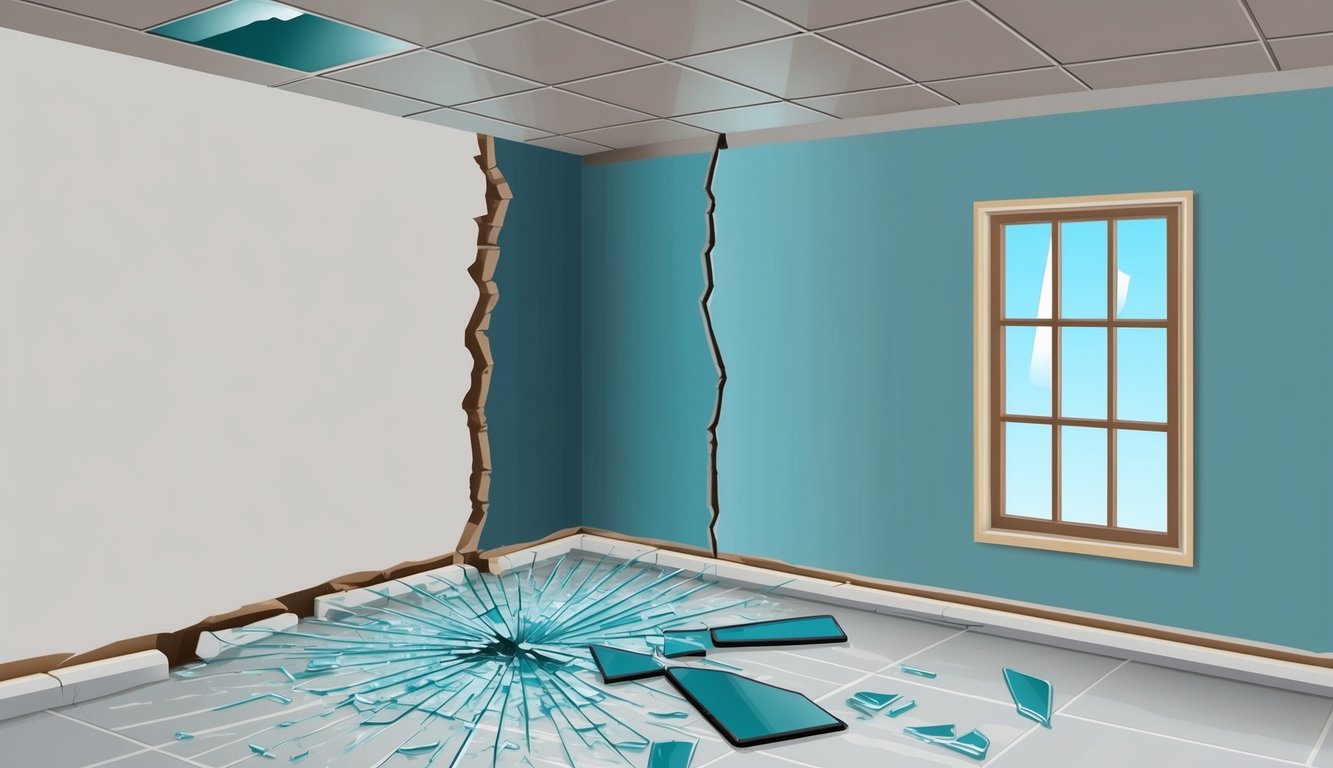
Many homeowners believe their insurance won’t cover small damages, but this isn’t always true.
Your policy typically covers various types of damage, regardless of size.
Minor incidents like a broken window or small water leak are often included in standard coverage.
These issues may seem insignificant, but they can lead to more serious problems if left unaddressed.
It’s important to review your policy carefully to understand what’s covered. Home insurance policies usually have a deductible, which is the amount you pay out of pocket before coverage kicks in.
If the cost to repair minor damage exceeds your deductible, it’s worth filing a claim.
Keep in mind that frequent small claims might increase your premiums over time.
You should document all damage, no matter how minor.
Take photos and keep receipts for any repairs.
This evidence can be crucial if you need to file a claim later.
Remember, your insurance is there to protect you from financial loss.
Don’t hesitate to contact your insurer if you’re unsure whether minor damage is covered.
They can provide clarity on your specific policy and guide you through the claims process if necessary.
10) Home Insurance Also Covers Home Businesses
Many homeowners mistakenly believe their standard home insurance policy extends coverage to their home-based businesses.
This is a common misconception that can lead to significant financial risks.
Standard home insurance policies typically provide limited coverage for business-related equipment and activities conducted within the home.
The coverage is often insufficient for most home businesses.
Your home insurance may only cover a small amount of business property, usually around $2,500.
This is far less than the value of equipment and inventory many home businesses possess.
Liability coverage for business-related incidents is also generally excluded from standard home insurance policies.
If a client visits your home office and gets injured, you might not be protected.
To adequately protect your home business, you may need to add endorsements to your existing policy or purchase a separate business insurance policy.
These options can provide more comprehensive coverage for your business assets and liabilities.
It’s crucial to discuss your home business with your insurance agent.
They can help you understand your current coverage and recommend appropriate solutions to protect your business activities fully.
Don’t assume your home insurance has you covered.
Take proactive steps to ensure your home business is properly protected to avoid potential financial setbacks.
Clarifying Home Insurance Coverage
Home insurance policies can be complex, with many nuances in coverage and limits.
Understanding the specifics of your policy is crucial to ensure you have adequate protection for your home and belongings.
Understanding Policy Limits
Policy limits determine the maximum amount your insurance company will pay for a covered loss.
These limits vary based on the type of coverage and your specific policy.
For example, your dwelling coverage limit should reflect the cost to rebuild your home, not its market value.
Personal property coverage typically ranges from 50% to 70% of your dwelling coverage.
It’s important to review these limits regularly and adjust them as needed.
High-value items like jewelry or art may require additional coverage.
Liability coverage protects you if someone is injured on your property.
Standard policies often provide $100,000 to $300,000 in liability protection, but you can increase this for added security.
What Home Insurance Truly Covers
Home insurance protects against specific perils listed in your policy.
Standard policies typically cover damage from fire, wind, hail, and theft.
However, not all natural disasters are covered.
Flood and earthquake damage usually require separate policies.
It’s a common misconception that all water damage is covered.
While burst pipes are often included, flooding from external sources is not.
Your policy may cover other structures on your property, like sheds or detached garages, but coverage is typically limited to about 10% of your dwelling coverage.
Personal belongings are usually covered both at home and away, but with limitations.
It’s crucial to read your policy carefully and discuss any questions with your insurance agent to ensure you understand your coverage fully.
Dispelling Cost-Related Myths
Home insurance costs can be confusing, with many misconceptions about pricing and factors influencing premiums.
Understanding the true expenses and what impacts them is crucial for homeowners seeking adequate coverage.
The Real Cost of Home Insurance
Home insurance is often more affordable than you might think.
The average monthly cost is around $158, though this can vary widely based on location and coverage levels.
Don’t assume insurance is a financial burden.
While it’s an additional expense, the protection it offers far outweighs the cost.
Consider it an investment in your property’s security.
You can often find ways to reduce your premiums.
Shopping around, bundling policies, and increasing your deductible are effective strategies to lower costs without sacrificing essential coverage.
Factors Affecting Premiums
Older homes typically cost more to insure.
This is because aging materials, outdated building codes, and potentially higher repair costs affect their insurability.
Your home’s location significantly impacts premiums.
Areas prone to natural disasters or with high crime rates often have higher insurance costs.
The amount of coverage you choose directly affects your premium.
Higher coverage limits and additional endorsements will increase your costs but provide more comprehensive protection.
Your credit score can influence your insurance rates.
Maintaining good credit may help you secure lower premiums.


